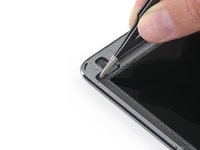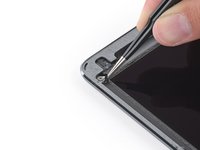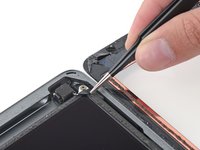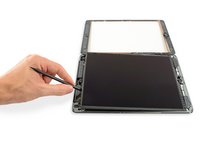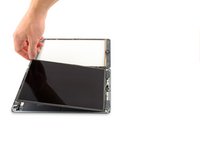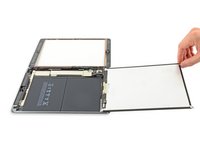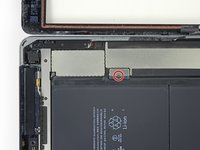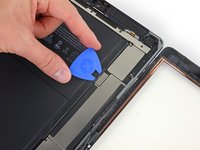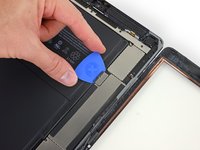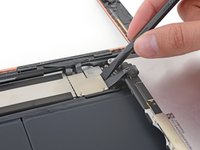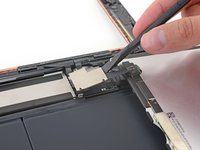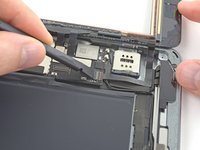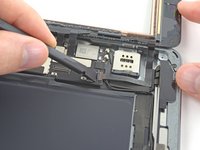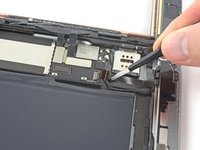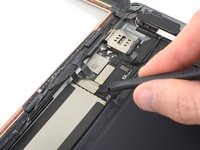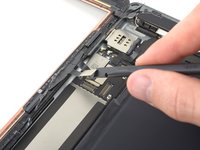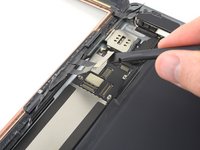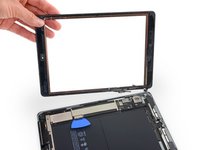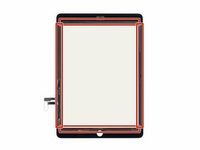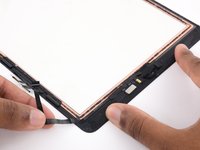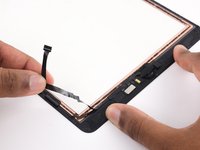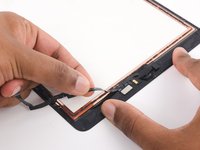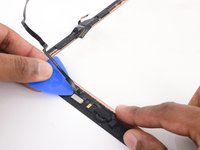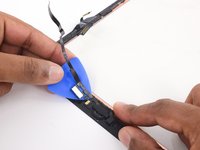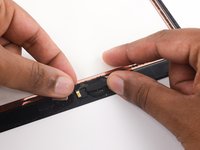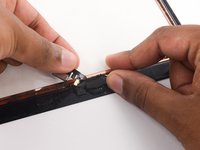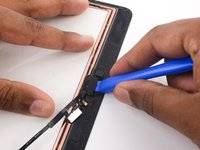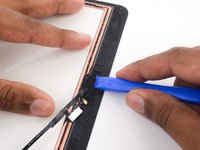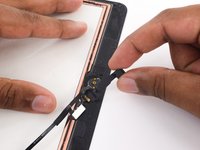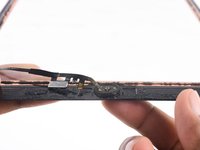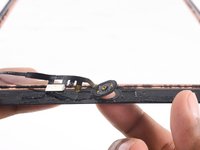
iPad 5 LTE Frontpanel-Baugruppe tauschen
Einleitung
Zu Schritt 1 der AnleitungHier wird der Austausch der Frontpanel-Baugruppe im iPad 5 LTE gezeigt.
Beachte, dass der Fingerabdrucksensor mit dem Logic Board gepaart ist, in dieser Anleitung wird auch der Home Button entfernt. Um weiterhin die Funktion Touch ID verwenden zu können, musst du den originalen Home Button auf die neue Front Panel Einheit übertragen.
Einige Bilder stammen vom WiFi-Modell und können sich leicht unterscheiden. Das Verfahren ist aber grundsätzlich gleich.
Warnhinweis: Die in der Anleitung beschriebene Methode zum Isolieren des Akkus ist überholt. Du kannst mit ihr die Akkukontakte dauerhaft beschädigen, bzw zerstören. Wenn du trotzdem den Akku auf diese Weise isolieren willst, dann befolge die Warnhinweise ganz genau und arbeite sehr sorgfältig. Wenn du aber weiterarbeitest, ohne den Akku zu isolieren, dann vermeide den Gebrauch von Metallwerkzeugen, außer wo unbedingt notwendig (z.B. um Schrauben zu entfernen). Dadurch beugst du einem Kurzschließen des Akkus und der empfindlichen Elektronik vor.
Was du brauchst
Fix Kit
Dieses Kit enthält alle Ersatzteile und Werkzeuge, die für die Anleitung benötigt werden.
Ersatzteile
Werkzeuge
Mehr anzeigen …
-
-
Lege einen erwärmten iOpener zwei Minuten lang auf die linke Seitenkante des Gerätes.
-
-
-
Während du darauf wartest, dass der Kleber weich wird, schaue dir die Stellen an, an denen das Hebeln gefährlich ist:
-
Frontkamera
-
Antennen
-
Displaykabel
-
-
In diesem Schritt verwendetes Werkzeug:Clampy - Anti-Clamp$24.95
-
Drücke den blauen Griff zurück, um die Arme zu entriegeln.
-
Lege das iPad so auf einen Gegenstand, dass es waagrecht auf gleicher Höhe zwischen den beiden Armen liegt.
-
Bringe die Saugheber mittig nahe an der linken Kante des iPads an, einen auf der Vorderseite, den anderen auf der Rückseite.
-
Halte die Anti-Clamp unten gut fest und drücke fest auf den oberen Saugheber, damit er sich festsaugt.
-
-
-
Drücke den blauen Griff vorwärts, um die Arme wieder zu verriegeln.
-
Drehe den Griff eine volle Umdrehung im Uhrzeigersinn, bzw. so weit, bis du merkst, dass sich die Saugheber dehnen.
-
Achte darauf, dass sich die Saugheber weiterhin gegenüber stehen. Wenn sie sich nicht mehr gegenüber stehen, dann löse die Saugheber ein wenig ab und schiebe sie in die richtige Position.
-
-
-
Warte eine Minute, damit sich der Kleber allmählich ablösen und sich ein Spalt bilden kann.
-
Wenn das Display nicht heiß genug ist, dann erwärme die linke Kante des iPads mit einem Haartrockner.
-
Wenn der Spalt groß genug ist, dann setze ein Plektrum unter den Touchscreen ein.
-
Überspringe den nächsten Schritt.
-
-
-
Wenn das Display zu heiß zum Anfassen ist, bringe einen Saugheber am linken Rand des Displays so nahe wie möglich an der Seitenkante an.
-
Hebe das Display mit dem Saugheber an, bis ein schmaler Spalt zwischen dem Touchscreen und dem Rahmen entstanden ist.
-
Setze ein Plektrum in den Spalt zwischen dem Touchscreen und dem Rahmen ein.
I had a screen that was lightly cracked, and when I pulled up on the glass it cracked even further and made a mess of my removal. So, I would recommend taping cracks even if you can get suction so that you don’t induce even more cracks.
I actually had a really badly cracked digitizer. Using the suction cup did nothing but shatter the digitizer more. I intentionally drove a flat head screw driver into the digitizer to reveal the recess in the body where they are showing the opening-pick. Working around the edge, the glass shattered. You still need to be careful at all of spots noted in step 2.
Do not go under the digitizer more than the 1 mm along the sides or 3-4 mm at the corners as shown in step 29 using the flat grey ring around the edge for a reference. Direct all of your tool force into the body to prevent slipping into critical parts.
The antennas at either side of the home button were the trickiest part as they were thin and slightly attached to the digitizer. I would recommend using a plastic tool for these parts if you are having to 'scrape' the glass off of the tabs of the antenna.
-
-
-
Setze ein zweites Plektrum in den eben erzeugten Spalt ein.
-
Schiebe das Plektrum zum Auftrennen des Klebers zur unteren linken Ecke des Gerätes hin.
-
Lasse das Plektrum in der unteren linken Ecke stecken, damit sich der Kleber nicht wieder verbinden kann.
-
-
-
Wenn das Plektrum im Kleber stecken bleibt, dann "rolle" das Plektrum an der Seite entlang, um den Kleber weiter aufzutrennen.
-
-
-
Schiebe das erste Plektrum zum Auftrennen des Klebers zur oberen linken Ecke des Gerätes hin.
-
Lasse das Plektrum in der oberen linken Ecke stecken, damit sich der Kleber nicht wieder verbinden kann.
-
-
-
Lege einen erwärmten iOpener zwei Minuten lang auf die Oberkante des Gerätes.
-
-
-
Schiebe das Plektrum um die obere linke Ecke herum, um den Kleber aufzutrennen.
-
-
-
Schiebe das Plektrum an der Oberkante des Gerätes entlang, halte unmittelbar vor der Frontkamera an.
-
-
-
Ziehe das Plektrum heraus, bis es nur noch mit der Spitze zwischen Touchscreen und Rahmen steckt.
-
Schiebe das Plektrum über die Kamera weg und trenne den Kleber auf.
-
Lasse das Plektrum gleich rechts neben der Kamera stecken, bevor du weiterarbeitest.
-
-
-
Setze das Plektrum wieder ein und schiebe es zur oberen rechten Ecke hin, um den Kleber ganz aufzutrennen.
-
Lasse das Plektrum in der oberen rechten Ecke stecken, damit sich der Kleber nicht wieder verbinden kann.
-
-
-
Lege einen erwärmten iOpener zwei Minuten lang auf die rechte Kante des Gerätes.
-
-
-
-
Rolle das Plektrum um die obere rechte Ecke des Gerätes herum und trenne den Kleber auf.
-
-
-
Setze ein weiteres Plektrum ein und schiebe es bis zur Mitte der rechten Seitenkante hin.
There are sensitive display/digitizer cables no less than five inches from the bottom edge of the iPad. Insert the pick further down than this, or deeper than 1mm beyond this point and you risk irreparably damaging these cables.
Three inches is much too far down this side of the iPad to use picks.
-
-
-
Lege einen erwärmten iOpener zwei Minuten lang auf die Unterkante des iPads.
-
-
-
Schiebe das Plektrum unten links zur unteren linken Ecke hin und trenne den Kleber auf.
-
Lasse das Plektrum in der Ecke stecken und gehe zum nächsten Schritt über.
-
-
-
Setze ein weiteres Plektrum in den eben an der Unterkante des iPads erzeugten Spalt ein.
-
Schiebe das Plektrum über die Antenne weg, halte kurz vor dem Home Button an.
-
Lasse das Plektrum links vom Home Button stecken und arbeite dann weiter.
-
-
-
Setze ein Plektrum in den eben erzeugten Spalt ein.
-
Schiebe das Plektrum unter den Home Button und zur unteren rechten Ecke hin. Achte darauf, dass das Plektrum nur mit der Spitze zwischen Touchscreen und Rahmen ist.
-
-
-
Setze das Plektrum wieder tiefer ein und schiebe es zum Auftrennen des Klebers in Richtung Home Button.
-
Lasse das Plektrum rechts vom Home Button stecken und arbeite dann weiter.
-
-
-
Lege einen erwärmten iOpener zwei Minuten lang auf die rechte Seitenkante des Gerätes.
-
-
-
Verdrehe die beiden Plektren in den linken Ecken des iPads bis sich der Touchscreen leicht anhebt, um so die letzten Klebestellen aufzutrennen.
-
-
-
Hebe den Touchscreen an der linken Kante nach oben, um den Kleber an der rechten Seitenkante weiter aufzutrennen.
-
-
-
Halte den Touchscreen fest und schiebe gleichzeitig ein Plektrum zwischen die beiden Displaykabel, um den letzten Kleber aufzuschneiden.
-
-
-
Wenn der Kleber komplett aufgetrennt ist, dann öffne den Touchscreen wie ein Buch und lege ihn parallel zum iPad hin.
While reassembling, REALLY make sure the display cables and the home button cable won't be folded / bent while closing the digitizer. I'm not exactly sure what I did, but I broke the home button and touch ID since I bent the home button cable to the point that it broke. These ribbon cables are SUPER fragile.
-
-
-
Entferne jegliches Klebeband, welches noch die Schrauben des LCD verdeckt.
-
-
-
Entferne die vier Kreuzschlitzschrauben, welche das LCD befestigen:
-
Drei 4,0 mm Schrauben
-
Eine 4,8 mm Schraube
-
-
-
Hebe das LCD mit dem flachen Ende des Spudgers aus seiner Vertiefung gerade soweit hoch , dass du es mit den Fingern fassen kannst.
-
Klappe das LCD wie eine Buchseite um, hebe es dabei an der Seite nahe der Frontkamera an und drehe es um die Kante nahe des Home Buttons.
-
Lege das LCD mit der Scheibe nach unten, so dass du Zugang zu den Displaykabeln erhältst.
Pictures that better indicate the difference between the remaining adhesive and the two mylar cables (the very cables you are trying to avoid damaging!) would be much appreciated. On my unit the two were very hard to distinguish
-
-
-
Entferne die einzelne 2,3 mm Kreuzschlitzschraube, welche den Akkustecker am Logic Board befestigt.
-
Lasse den Akkublocker stecken, damit die Akkuanschlüsse während der Reparatur keinen Kontakt haben.
The could recommend me since I did not put the wedge first in the connection of the battery and it heated the logic card a couple of minutes, q´l recommend to solve it since it does not turn on
The battery isolation pick didn’t come with my kit. I made my own using one of the regular picks and a pair of scissors.
Would it not be important to note that you are not really “disconnecting” the conduit of the battery from the logic board, but rather isolating the connection?
@dlcatftwin I’m not sure I understand the distinction you’re making. You are fully disconnecting the battery, by opening the circuit and wedging a big insulator in there to keep it from closing again accidentally.
Hello Jeff,
Thank you for responding. one may regard “disconnecting” as actually unplugging or unsocketing a cable connection as actually disconnecting, like in step 37. I could picture a person tugging on the pick thinking that the battery connector actually had to be lifted away from the board.
Probably over-thinking it! ;-)
Regards,
DLC
@dlcatftwin 100% on point. That’s exactly why I’m reading this comment right now. I’ve never heard of a “Battery Isolation Pick” and I was trying to get the connector loose, before realizing it wasn’t coming easy and therefore reading the comments for more info.
Ergo, there is some confusion here that should be noted in the primary instructions.
-
-
-
Entferne die drei 1,4 mm Kreuzschlitzschrauben, welche die Halterung des Displaykabels befestigen.
-
-
-
Hebele die Halterung des Displaykabels vorsichtig mit dem flachen Ende des Spudgers vom Logic Board gerade hoch.
My iPad Air2 is configured differently from that in these photos. The battery connector is next to the display cable connection, and the LCD/glass panel are integral, so that they lift out of the frame together.
-
-
-
Entferne alle Klebebänder, die den Flachbandkabelanschluss des Home Buttons abdecken.
-
-
-
Verwende das flache Ende eines Spudgers, um die Lasche am ZIF-Anschluss des Home-Tastenbandkabels nach oben zu klappen .
-
Ziehe das Home-Button-Flachbandkabel vorsichtig aus dem ZIF-Stecker heraus.
On reassembly take note of the flap lock on that connection. Sadly I failed to operate it correctly and now have a defunct home button.
-
-
-
Verwende das flache Ende eines Spudgers oder eines Fingernagels, um die beiden Digitizerkabelstecker gerade aus ihren Sockeln zu lösen.
When reversing with the new screen , this was the hardest part for me.
The cables needs to fit under the LCD screen, and they kept going out of place when I tried to close the screen in the end.
That meant that I had to remove the LCD again with one hand while holding the digitizer/glass with the other - all while I had already exposed the adhesives.
for me the cables of the new screen were longer that the old one. So even if i put everithing under the lcd, the digitizer didnt close properly. After everything was put back togheter, this side of the digitizer keep popping out.
I do have the same problem.
Anne -
In step 41 - what is the name of the connector in the first picture which he is trying to open
It is a ZIF socket. (Zero insertion force)
Zach -
-
-
In diesem Schritt verwendetes Werkzeug:Polyimide Tape$9.99
-
Entferne die Front Panel Einheit.
After removing the glass, I'd suggest scraping off any remaining black adhesive off of the iPad's frame. Get every speck. This may be time consuming if you have lost glass integrity and have sticky, splintered shards around the edge of the frame, but you need the frame completely clean of adhesive before you put the new front panel down or else it won't lay correctly in the frame.
This was not as hard as I expected it. I think I was lucky since the adhesive wasn’t properly working anymore, and my display wasn’t too shattered. Took me a about 40 minutes to remove the display. Unfortunately I noticed that my battery had expanded so ordered a new one, waiting for it to arrive before I put it all back together.
-
-
-
Beginne das Home Button Kabel vorsichtig von der Rückseite des Front Panels abzulösen.
-
Löse ab, bis du die Metallabschirmung am Kabel erreichst.
START using extreme caution at this point. This ribbon IS VERY FRAGILE, especially after the silver rectangle/shield. That gold piece is attached to the cable.
-
-
-
Setze einen Opening Pick (Plektrum) zwischen Metallabschirmung und Front Panel ein und löse sie vorsichtig vom Digitizer ab.
-
-
-
Löse vorsichtig den Metallkontakt von der Halteklammer des Home Button ab.
So what exactly does this metal contact do? Can the HB work without that single gold contact?
Can anyone answer this question? The gold metal rectangle contact ripped off even horizontally with the rest of the home button cable. Do I need to order a whole new home button with cable? Or will I at least get functionality from the home button, only missing that little gold rectangle ?
PC Ops -
I ripped mine. Reattached the metal contact to the cable with some tape as best as I could. The button and touch ID work, so not sure if the metal contact is absolutely needed…? If it’s just for grounding?
EXTREME CAUTION!!! The little metal contact is very fragile. I ripped mine off. Well, when I say ripped I mean I breathed on it.
I would suggest maybe warming that part up before pulling and don’t just pull up from the main ribbon. Work it slowly.
CAUTION!!! that little gold contact got me too!! Please update the instructions to include this.
Did you find out if the home button still works without the rectangular gold contact?
PC Ops -
-
-
-
Heble die Halteklammer des Home Buttons mit einem Plastiköffnungswerkzeug vorsichtig von der Rückseite des Front Panels.
-
Wenn eine Seite der Halteklammer befreit ist, kannst du sie fest anfassen und vom Front Panel abziehen.
I'd recommend using something stronger than double sided tape. I completed this whole repair without too much lasting trouble, but the biggest issue was I didn’t get the home bracket secured firmly enough. A few weeks after the repair, the home button got pressed in and lodged under the hole cut for it, so I can’t unlock my iPad at all (the home button can’t be “pressed” in its current state). So I’m ordering a second screen and have to go through everything again. This time I’m using super glue to get that thing welded on there. If anything breaks in the future, I’m just getting a new iPad.
I had this problem too. Very frustrating. Not sure what I’d do to fix this. If you are repairing this for someone else, then super glue would not be the best option.
I don’t see why iFixit does not simply sell an optional iPad screen with a new home button pre-installed - other competing companies do it, and with iFixit’s pro reputation, having a pre-installed option would certainly be an excellent sales option. My 2¢ worth.
The home button that came with your iPad is the only one that will allow touchID to function. This is why this must be migrated from the old to the new screen. Of course, if your iPad does not have touchID, this is not a concern.
Robert -
TIP FOR HOME BUTTON REMOVAL
I found it to be simpler by using the same pry tool shown in the image and pry the tab furthest from the flex cable. Its an easy start knowing that if you damage the cable you can loose Touch ID permanently.
My steps were basically as follows in this specific order:
1. Using a guitar pick, release the cable from the adhesive and SLOWLY lift up the cable and the components with it
2. Once you reach the tabs that hold the home button in place, pry the tab furthest from the flex cable (this requires a little more force)
3. Once the tab furthest from the home button is lifted away, you can hold on to the metal piece (The whole tab) and lift it away safely.
4. Using your finger, press in the home button to release it from the glass and your done.
After replacement m home button works fine, but it’s very loose in the housing. I can tip it around by moving my fingers to the edges. Any ideas what I did wrong?
I had to use far more pressure to remove the bracket than I was comfortable with and when it came loose it went flying. Re-attaching is easy, but I used some hobby glue to secure it in place, so if the screen breaks again, that part is NOT coming off again. I’m guessing because I did this I don’t have the “depressed” issues that others have described, it seems to be like new at this point.
I agree, the bracket needs glueing when refitting. Replaced the glass on my iPad and after a couple of days the home button came loose and stopped working. Now i just broke the glass when opening the iPad to fix the home button bracket. I love my life! :-)
I used a piece of the rectangular section of an adhesive strip cut to the exact size of the home button bracket feet to reattach it to the digitizer for reassembly. It is very strong and worked better than double sided tape or glue.
agree. I did same. Also do not forget to remove protective film from the inner side of the new digitizer. Do it before you start reassembly.
-
-
-
Drücke auf den Home Button von außen her, um den Kleber aufzubrechen der ihn festhält.
Are these last several steps necessary in just replacing the front glass panel that is cracked? my ipad is a wi-fi only
Yes, even if you’re only replacing the front glass panel, you still have to transfer your original home button from the old panel to the replacement. Even if the new panel comes with a new home button, Touch ID will only work with the original home button.
Buy an extra home button adhesive gasket. The adhesive from the original will not be reusable
I second this advice. I skipped it the first time, and the home button was too wiggly (although it worked). Now that I’ve replaced the screen a 2nd time (ugh), this time adding a new gasket, it’s a bit more firm, but still more wiggly than originally. If you don’t mind the button being lose, you probably can reuse the gasket, but if I have to do this again, I’ll probably get another gasket.
Yep, tore mine even as delicate as could be. I would highly recommend hitting the home button with a heat gun prior to attempting to remove. On the plus side, the replacement gaskets are cheap and easy enough to replace.
My screen was damaged in such a way that removing the old gasket didn't tell me how to install the new one.
I completed the reassembly of my digitizer. the process was pretty simple. After reviewing all the feedback and issues mentioned by others, I made sure to properly attach the home button/touch ID to my new screen by carefully installing it and ensuring the gasket was firmly in place. I used a small amount of liquid glue to secure the bracket as well. While everything is working correctly, I did notice that my repair kit came with a new bracket and home button gasket (with adhesive on the parts I used glue- I assume) lol. I clearly didn't utilize that… do you think I’ll be okay? I just hope I won't need to redo the whole process again just for the home button. 🤦🏻♀️ I don’t know how I missed that little baggie…
-
-
-
Entferne die Home Button Einheit.
Nicely done!
Be very careful !!!!
Given the delicacy of this stage, I believe it behooves iFixit to offer a panel replacement option with a new Home button pre-installed.
Others do; with iFixit’s reputation, such a purchase option would be a welcome, stellar addition to its inventory. Yes, you would have to cancel your Touch-ID setting prior to repair, but that’s a small inconvenience to having to negotiate such a procedure. My 2¢ worth.
Thanks, iFixit, for the excellent instructions
I second this - tore the home button cable during disassembly and ordered another home button assembly just to figure out that I need the gasket and holder as well as it was not included. -
Yes - the metal contact on the home button tore… now I have to figure out how to do another repair. Also, my replacement screen comes with plastic on both sides and multiple tabs in different colors. Now I’m too scared to remove those for fear of ripping something.. you should have glass replace directions here too.
Hi sir
Iam try replace ditigizer on iPad 6th gen
Will my home button and finger print if I replace the home to another the home button will if I buy it from you guys
replaced the display with new home button assembly, new gasket, and holder - button works but fingerprint sensor not anymore - It would be great to have detailed instructions for the complete the home button assembly with all the different parts, not only the teardown for reference. - i.e. it seems you need to push the button through the gasket before assembly so the cable leaves inside and the order is glass-button-gasket-holder.
The article explicitly states that the Home Button and the Motherboard are a BONDED PAIR. If you replace one without the other, Touch ID will stop working. This is why the instruction say you have to retain the button.
While I’m a fairly tech savvy person, telling people to reverse the steps is ridiculous—you need to show people what to expect. Second, include the home button on the new screen sale. I’m in the middle of the repair at this point, I’ve given you $100 and this seriously frustrating, especially when the home button you sell (which I had to buy after the screen, because I inadvertently tore off a bit) DOESN”T include the proper adhesive. PS—trying to get the adhesive on the new button is a practice in torture.
I had to notch out the glass adhesive just slightly where bottom right corner of the home button bracket sits against it. It is curved and needed to be squared off to match the bracket. I held the ribbon cable, button and bracket in place with tape before I glued the bracket. I also used a flashlight behind the bracket and button gap to see that the bump on the bracket was lined up with the button’s switch.
I'm quite disappointed the fact that this is a replacement guide but does not include re-assembly steps.
We ordered a new home button and gasket for an iPad 5, which works with the iPad 6 home button as well.
Neither guide has re-assembly instructions for the home button.
My customer service is important and I would like to see better guides that include disassembly and reassembly steps.
I need to know how to properly apply a home button gasket to the home button.
If I am missing something, please let me know.
PS. It's not good practice to use metal tools so close to the main board. An insolated pair would be more ideal.
The small black dot on the home button microswitch comes off no matter how careful you are. Home button will not work properly if you loose the black dot. I have done 5-6 repairs and on 4 of them the black dot just fell off. I have been successful using a small piece of Kapton tape and reinstalling the black dot in the center of the home button microswitch.
I also removed a metal ring that sits between the gasket and the glass. It has the same shape of the gasket, and it’s glued to the glass after removing the home button assembly. Used a thin double-sided tape with strong glue when reassembling; maybe B7000 glue would be easier.
It's so frustrating seeing these guides that just say “follow these steps in the reverse order" when I'm really searching for a technique and guidance on replacing the rubber gasket and and proper placement of the bracket so it clicks as it should and doesn't sink in.
Agree with previous comments. Would be helpful to go over replacing the button gasket, and the actual reassembly instead of just ‘reverse order’.
it would be nice to see how to re assemble when to pull backing off glue, how to add grommet, how to bend new wires in place to seat correctly
Would I be able to use the new replacement home button as to go back to home page? Or is it just going to he for the decoration?
I needed 6 hours for
1) removing the cracked display glass with a scalpell,
2) to remove the glue with glue remover,
3) to install a new home button (because I cutted the homebutten flex-cable) and
4) to glue the touchdisplay (digitizer) with T7000 diplay glue!!!. The delivered glueband on the digitizer shouldn't be used, because it is to weak.
There is a HowTo missing to install a new home button. I also didn't found a new homebutton from iFixit. So I had to buy it somewere else.
-
Um dein Gerät wieder zusammenzubauen, folge den Schritten in umgekehrter Reihenfolge.
Um dein Gerät wieder zusammenzubauen, folge den Schritten in umgekehrter Reihenfolge.
Rückgängig: Ich habe diese Anleitung nicht absolviert.
35 weitere Personen haben diese Anleitung absolviert.
Besonderer Dank geht an diese Übersetzer:innen:
100%
Diese Übersetzer:innen helfen uns, die Welt zu reparieren! Wie kann ich mithelfen?
Hier starten ›
6 Kommentare
I was able to complete this repair although the screen on the iPad that I was trying to repair was completely shattered and I ended up having to just take it out in chunks. A little more detail about best practices in that situation would be good. I also am having some issues with the home button not being quiet right after the repair and now that I am seeing that I would have purchased a replacement for the adhesive holder piece when I got the screen. It is working fine for now and I plan to just be careful with it so I don’t have to pull the display again and risk messing up the screen adhesive and having to order another set of that again too.
It didn´t work for me. I did this repair 2 times.
At the first try, the front glass was not totaly fixed, so I I used 10 strong clamps to get a better connection, but the glass was not really fixed and broke again with a new one.
So I tried twice. I cleaned everything very well, waited half an hour before I put the glass on the ipad. I put it on a flat surface on top with some haevy gear for 24 hours. After only some days the glass lost connection at the right down side where the cables are. So the display got a crack again.
I asked ifixit to fix this.
They told me: This is my fault.
Most likely you did not route the display cables down into between the housing and the lcd this is tricky if done right and the chassie is not bent and no debre is left the screen should adhear no problem. I have done many of these with no issues.
I like the instructions for how to get the new panel on "do this all in reverse, completely useless. I want to know how to glue the home button back onto the new panel, where to run each wire now that the tape is all removed, how to get the new screen on, seems half done. Can we just update it to have reassembly instructions. also the kit no longer comes with that tool and it says "skip ahead to alternative" and there is none, and the suction cup is 100% useless, it does not suck at all, no matter how perfect the glass is under it or how hard you press it on, you can just blow on it and it will move, no force at all required and it immediately comes off. Just forget the toolkit, but the screen and watch some youtube videos, this guide and toolkit are useless.
Nearby exactly as shown in description. Repair successful completed
Many thanks

















































































































































